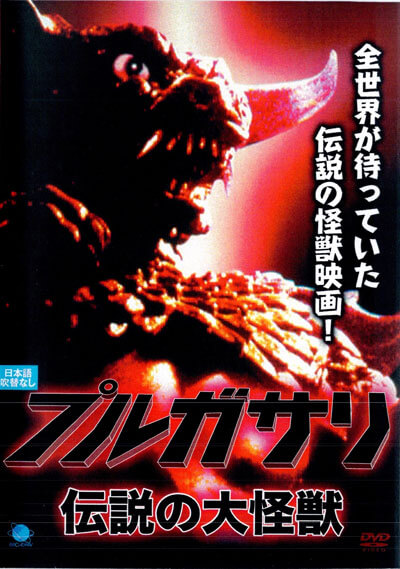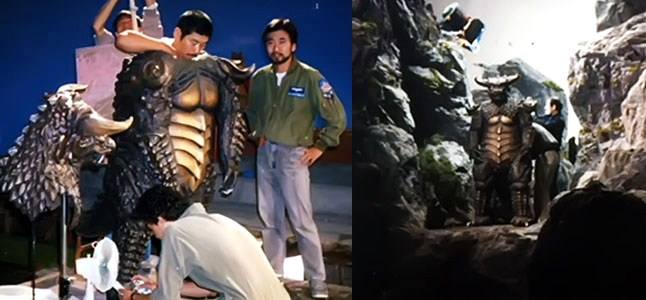PULGASARI, 1985
Pulgasari, certainly among the most infamous cultural exports of North Korea, is an altogether different beast than any other film produced by North Korea. While Godzilla was born of the Japanese’ commentary on nuclear energy, Pulgasari was born of North Korea’s commentary on class struggle. The film is unusual in the North Korean cinematic canon for both its fantasy subject matter and visual dynamism. Owing to director Shin Sang-Ok’s long career as a revered South Korean — before he became a North Korean — director, the film calls upon a wealth of flashy camera techniques and more appealing art direction than most previously produced North Korean films. The soundscape, too, is more complex. The synthesized score is at once a product of its time and evocative of traditional Korean melodies.

What is the story line of Pulgasari?
The film is set in feudal Songdo (today, Kaesong) Korea, where the virtuous peasants are terrorized by a tyrannical governor who seizes all of their iron tools and utensils. A blacksmith is jailed when he refuses to turn the tools into swords for the governor’s army. In jail, he sculpts a glob of rice into a small figure of a horned creature. “Because I made you with the last of my true heart,” he tells the sculpture during an emotional monologue, “please save humanity in my place.” The blacksmith dies and his daughter Ami finds the sculpture in his hand.
To read about the North Korean Film Studio Click here
Later, Ami pricks her finger while sewing and a drop of blood lands on the sculpture, which comes to life and eats Ami’s sewing needle. From there, it consumes all of the iron in sight and grows into a giant monster, Pulgasari. Pulgasari fights alongside the farmers to take down the wicked governor. However, Pulgasari outlasts its usefulness, and, after devouring the enemy’s weapons, he begins to scarf down the farmers’ tools. Ami hides in a large bell and is consumed by the monster which causes Pulgasari to explode. Some have suggested that Shin hid within Pulgasari a criticism of Kim Il Sung; the once champion and liberator of the people was now depriving his people to enrich itself.

Is it just a Godzilla rip-off?
While the film is often mocked as a so-bad-it’s-good Godzilla rip-off, it actually has more legitimate ties to Gozilla than many knock-offs. Shin hired Toho Studios hot off the heels of Godzilla 1985 to design Pulgasari. Kenpachiro Satsuma, who donned the monster suit in Godzilla 1985 was also hired to portray Pulgasari on screen. Satsuma and 15 Toho technicians first worked on the film at Beijing Dian Ying Studios and then in North Korea where they were housed in a mansion that purportedly belonged to Kim Jong Il.
How good is it?
Not only did Satuma later say that he preferred the Pulgasari suit to the one used in Godzilla 1985, he later told an audience at the 2014 Bib Wow Comicfest: “When people saw Pulgasari, people from Toho were actually saying it was more entertaining than Godzilla, 1985…” Satsuma later wrote a book about the experience called North Korea Seen Through The Eyes of Godzilla. Unfortunately, it has yet to receive an English translation.
For Pulgasari, the Toho technicians employed the same photographic tricks of scale used in Godzilla 1985, though to lesser effect. The titular monster, Pulgasari, is the only skyscraper-scale beast in the film, so we have little reference for a true sense of his size. More problematic yet, being a period piece, there is no towering skyline for us to compare him to. He is typically seen lumbering among plastic treetops or against a bright blue sky, which fails to capture his intended size in the same way as a lizard ravaging a cardboard Tokyo.
However, the inverse is pulled off beautifully. Pulgasari begins his life small enough to fit inside the palm of our protagonist’s hands, and a scene early on where he sparks to life in her sewing box works rather convincingly. The scene is achieved using an oversized set of the box for the monster to interact with while Ami looks on in disbelief, complete with enormous scissors and needles for scale.
Cinematography of Pulgasari
Pulgasari makes generous use of long zoom lenses, the camera always lurching into characters as they deliver dialog or trade blows. It taps into some of the raw kineticism of a Shaw Brothers production, with shaky handheld camerawork and brisk edits punctuating the action, capitalizing on the chaos between cuts to energize the battle scenes. This does lead to some confusing, nonexistent geography in the large-scale battle sequences pitting Pulgasari and the peasant army against the governor’s minions, though this isn’t an uncommon gripe in monster movies originating from any country.
What do North Koreans think about the film?
The film was a huge hit in North Korea. One of my guides in North Korea’s rural North Hamgyong province told me that when the film was released in 1985, he had to stand in the back of the theater in order to see it. Though Shin Sang-Ok’s name was subsequently scrubbed from its credits, with credit going to his assistant director Chong Gon Jo, and many North Koreans will discuss Pulgasari, it is seemingly unavailable today inside the DPRK. We owe the fact that copies still circulate to Japanese distributor Raging Thunder which released the film on VHS and in select theaters in Japan in 1998. When I contacted the man behind Raging Thunder’s release, the eccentric Fumio Furuya, he was hesitant to discuss his involvement. “Yeah, I did distribute that movie,” he said. “But the movie had already been…subtitled by someone else and I was just asked to distribute it. So, I wasn’t actually digging North Korean stuff…I mean, I’m not saying I don’t wanna do it. But it’s just that I don’t know enough to be interviewed and Japanese media might go against me if I do that.”
Watch Pulgasari for free online with English subtitles HERE.
Justine Martell is the co-founder of film location specialists Pioneer Media.






